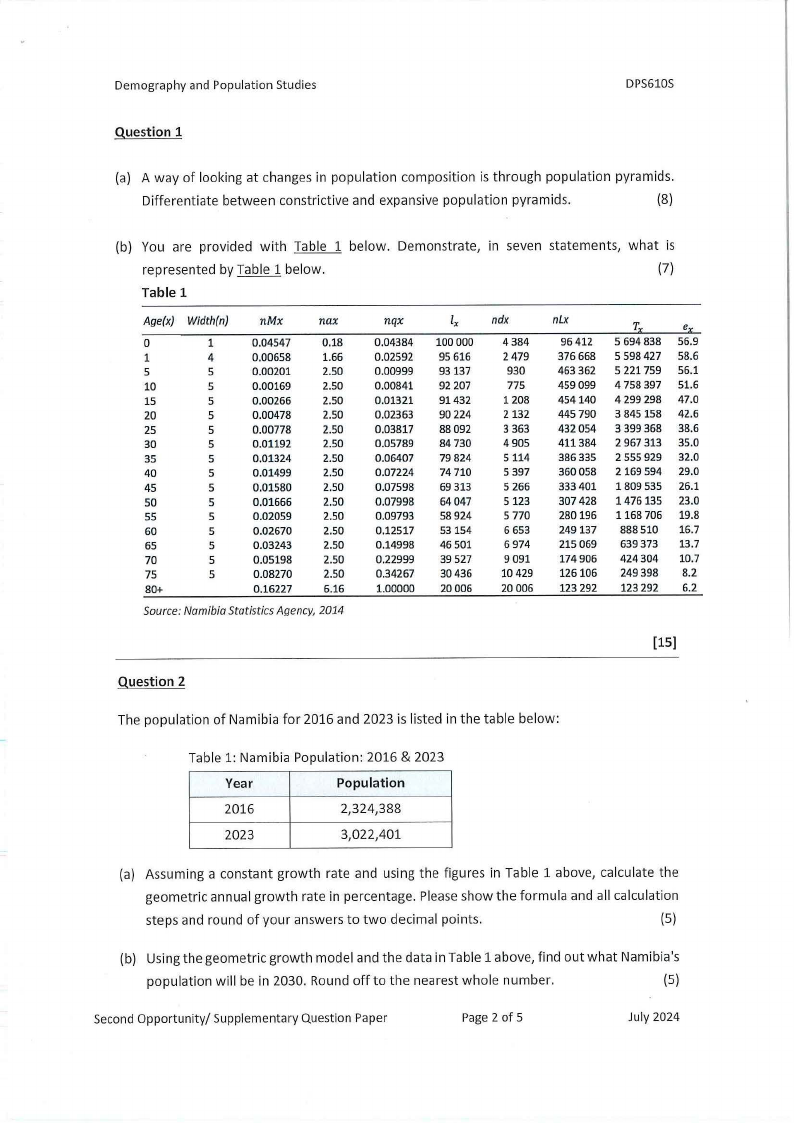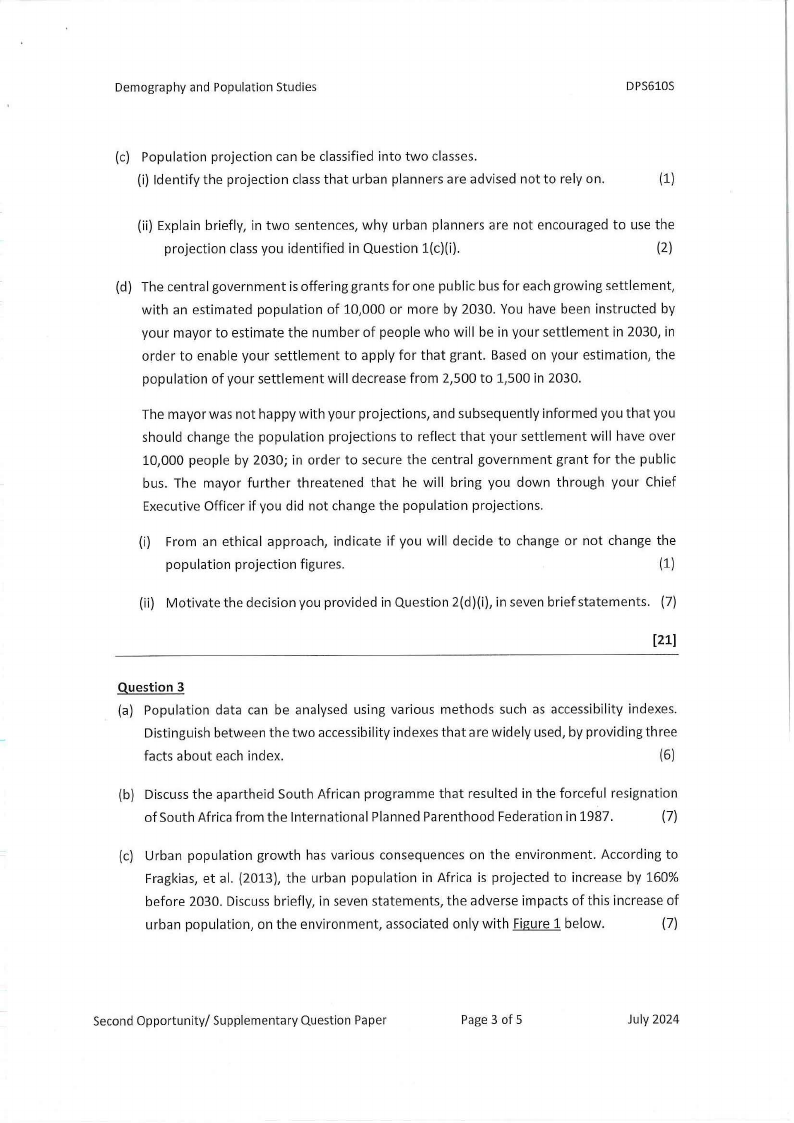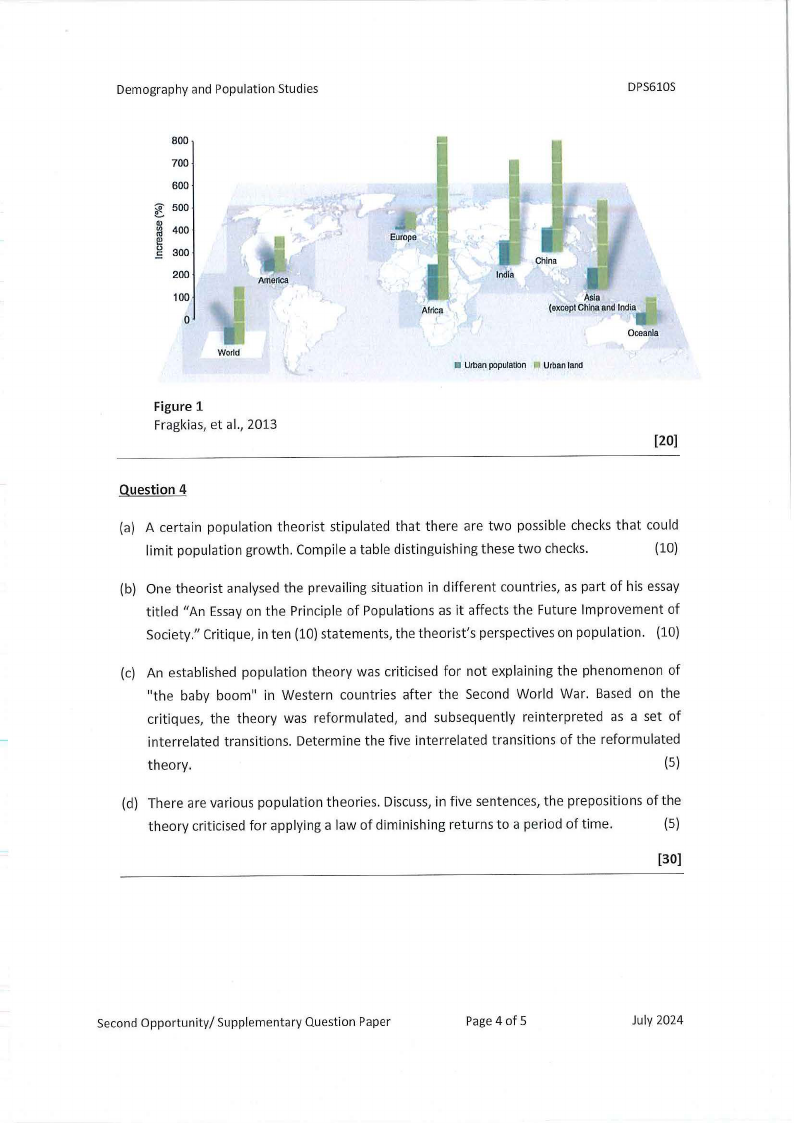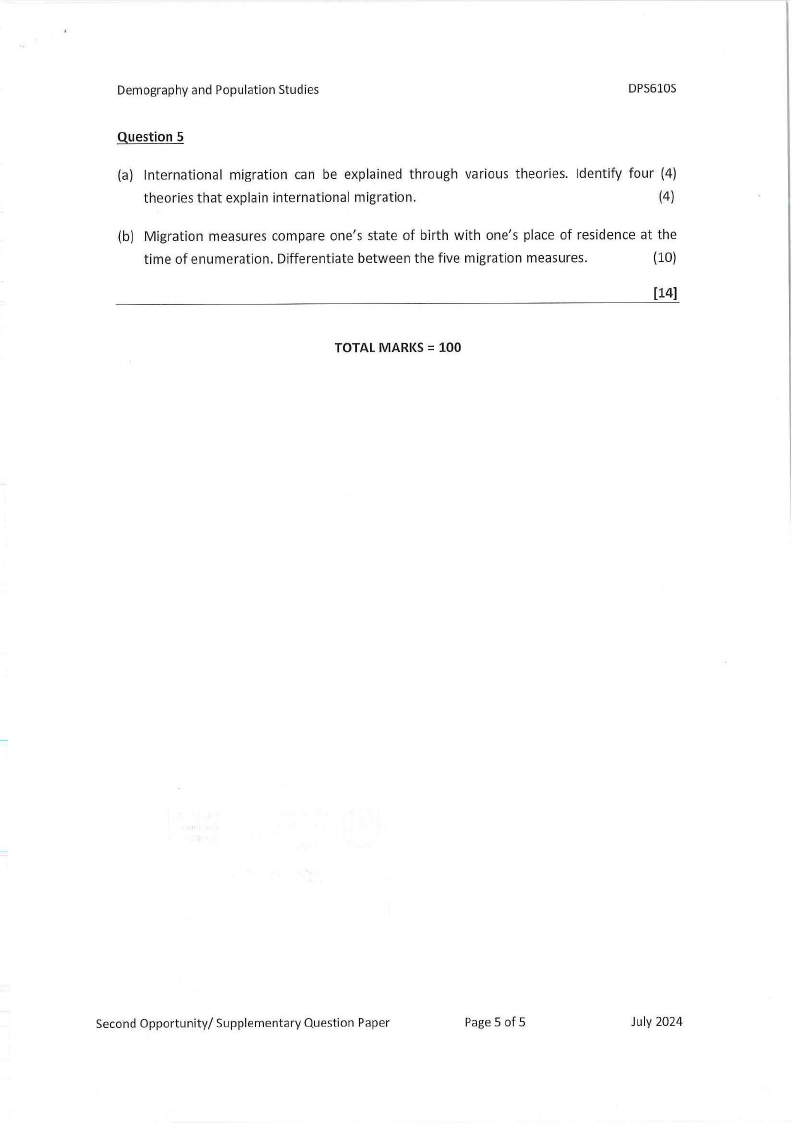 |
DPS610S - DEMOGRAPHY AND POPULATION STUDIES - 2ND OPP - JULY 2024 |
 |
1 Page 1 |
▲back to top |

nAmlBIA UnlVERSITY
OF SCIEnCE Ano TECHnOLOGY
FACULTYOF ENGINEERINGAND THE BUILTENVIRONMENT
DEPARTMENTOFARCHITECTURE,PLANNINGAND CONSTRUCTION
QUALIFICATION:BACHELOROF TOWN AND REGIONAL PLANNING
QUALIFICATION CODE: 07BTAR
NQF LEVEL:6
COURSECODE: DPS610S
COURSENAME: DEMOGRAPHY AND
POPULATION STUDIES
DATE: JULY 2024
PAPER: THEORY
DURATION: 3 HOURS
MARKS: 100
SECONDOPPORTUNITY/ SUPPLEMENTARYEXAMINATION QUESTION PAPER
EXAMINER
Ms. J. l<ohima
MODERATOR Dr. E. Yankson
NOTES:
1. Read the entire question paper before answering the questions.
2. You must answer all questions.
3. Ensure you number your answers correctly.
4. Please write clearly and legibly.
5. Ensure your Student Number is on the Examination Book(s).
THIS QUESTION PAPERCONSISTSOF 5 PAGES(including this front page)
 |
2 Page 2 |
▲back to top |

Demography and Population Studies
DPS610S
Question 1
(a) A way of looking at changes in population composition is through population pyramids.
Differentiate between constrictive and expansive population pyramids.
(8)
(b) You are provided with Table 1 below. Demonstrate, in seven statements, what is
represented by Table 1 below.
(7)
Table 1
Age(x) Width(n) nMx
nax
0
1
0.04547
0.18
1
4
0.00658
1.66
5
5
0.00201
2.50
10
5
0.00169
2.50
15
5
0.00266
2.50
20
5
0.00478
2.50
25
5
0.00778
2.50
30
5
0.01192
2.50
35
5
0.01324
2.50
40
5
0.01499
2.50
45
5
0.01580
2.50
so
5
0.01666
2.50
55
5
0.02059
2.50
60
5
0.02670
2.50
65
5
0.03243
2.50
70
5
0.05198
2.50
75
5
0.08270
2.50
80+
0.16227
6.16
Source: Namibia Statistics Agency, 2014
nqx
0.04384
0.02592
0.00999
0.00841
0.01321
0.02363
0.03817
0.05789
0.06407
0.07224
0.07598
0.07998
0.09793
0.12517
0.14998
0.22999
0.34267
1.00000
lx
100 000
95 616
93137
92 207
91432
90224
88092
84 730
79824
74710
69 313
64047
58924
53154
46501
39527
30436
20 006
ndx
4384
2479
930
775
1208
2132
3 363
4905
5114
5 397
5 266
5123
5 770
6 653
6974
9091
10429
20006
nLx
T.
e
96 412 5 694 838 56.9
376 668 5 598427 58.6
463 362 5 221 759 56.1
459 099 4 758397 51.6
454140 4 299 298 47.0
445 790 3 845 158 42.6
432 054 3 399 368 38.6
411384 2 967 313 35.0
386 335 2 555 929 32.0
360 058 2169 594 29.0
333 401 1809 535 26.1
307 428 1476135 23.0
280196 1168 706 19.8
249137 888 510 16.7
215 069 639373 13.7
174 906 424 304 10.7
126106 249 398 8.2
123 292 123 292 6.2
[15]
Question 2
The population of Namibia for 2016 and 2023 is listed in the table below:
Table 1: Namibia Population: 2016 & 2023
Year
Population
2016
2,324,388
2023
3,022,401
(a) Assuming a constant growth rate and using the figures in Table 1 above, calculate the
geometric annual growth rate in percentage. Pleaseshow the formula and all calculation
steps and round of your answers to two decimal points.
(5)
(b) Using the geometric growth model and the data in Table 1 above, find out what Namibia's
population will be in 2030. Round off to the nearest whole number.
(5)
Second Opportunity/ Supplementary Question Paper
Page 2 of 5
July 2024
 |
3 Page 3 |
▲back to top |

Demography and Population Studies
DPS610S
(c) Population projection can be classified into two classes.
(i) Identify the projection class that urban planners are advised not to rely on.
(1)
(ii) Explain briefly, in two sentences, why urban planners are not encouraged to use the
projection class you identified in Question l(c)(i).
(2)
(d) The central government is offering grants for one public bus for each growing settlement,
with an estimated population of 10,000 or more by 2030. You have been instructed by
your mayor to estimate the number of people who will be in your settlement in 2030, in
order to enable your settlement to apply for that grant. Based on your estimation, the
population of your settlement will decrease from 2,500 to 1,500 in 2030.
The mayor was not happy with your projections, and subsequently informed you that you
should change the population projections to reflect that your settlement will have over
10,000 people by 2030; in order to secure the central government grant for the public
bus. The mayor further threatened that he will bring you down through your Chief
Executive Officer if you did not change the population projections.
(i) From an ethical approach, indicate if you will decide to change or not change the
population projection figures.
(1)
(ii) Motivate the decision you provided in Question 2(d)(i), in seven brief statements. (7)
[21)
Question 3
(a) Population data can be analysed using various methods such as accessibility indexes.
Distinguish between the two accessibility indexes that are widely used, by providing three
facts about each index.
(6)
(b) Discussthe apartheid South African programme that resulted in the forceful resignation
of South Africa from the International Planned Parenthood Federation in 1987.
(7)
(c) Urban population growth has various consequences on the environment. According to
Fragkias, et al. (2013), the urban population in Africa is projected to increase by 160%
before 2030. Discuss briefly, in seven statements, the adverse impacts of this increase of
urban population, on the environment, associated only with Figure 1 below.
(7)
Second Opportunity/ Supplementary Question Paper
Page 3 of 5
July 2024
 |
4 Page 4 |
▲back to top |

Demography and Population Studies
DPS6105
800
700
600
500
Ill
"'II) 400
I!!
0
5
300
200
100,
0
World
Figure 1
Fragkias, et al., 2013
Urbanpopulation Urbanland
Oceania
[20]
Question 4
(a) A certain population theorist stipulated that there are two possible checks that could
limit population growth. Compile a table distinguishing these two checks.
(10)
(b) One theorist analysed the prevailing situation in different countries, as part of his essay
titled "An Essayon the Principle of Populations as it affects the Future Improvement of
Society." Critique, in ten (10) statements, the theorist's perspectives on population. (10)
(c) An established population theory was criticised for not explaining the phenomenon of
"the baby boom" in Western countries after the Second World War. Based on the
critiques, the theory was reformulated, and subsequently reinterpreted as a set of
interrelated transitions. Determine the five interrelated transitions of the reformulated
theory.
(5)
(d) There are various population theories. Discuss, in five sentences, the prepositions of the
theory criticised for applying a law of diminishing returns to a period of time.
(5)
[30]
Second Opportunity/ Supplementary Question Paper
Page 4 of 5
July 2024
 |
5 Page 5 |
▲back to top |

Demography and Population Studies
DPS610S
Question 5
(a) International migration can be explained through various theories. Identify four (4)
theories that explain international migration.
(4)
(b) Migration measures compare one's state of birth with one's place of residence at the
time of enumeration. Differentiate between the five migration measures.
(10)
[14]
TOTAL MARKS= 100
Second Opportunity/ Supplementary Question Paper
Page 5 of 5
July 2024





